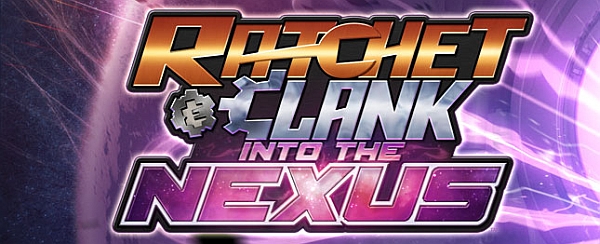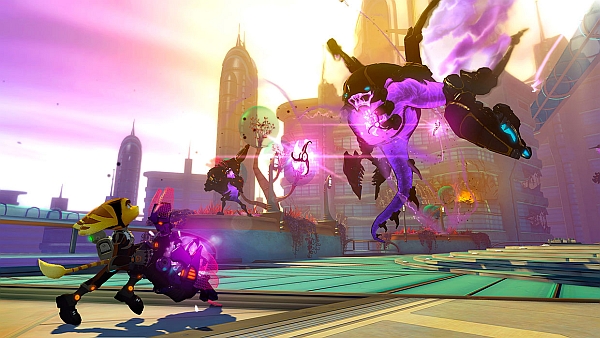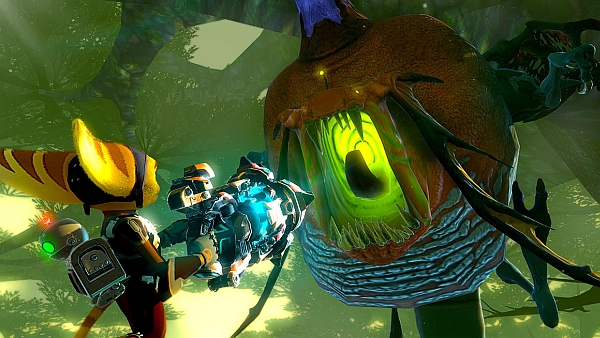
It can be a little intimidating to jump into the epilogue of a series when you’ve only sparingly dabbled in the franchise throughout the years. But Ratchet & Clank: Into the Nexus offers everything one would expect it to; steady gameplay with outlandish upgradeable weapons and some wise-cracking humor to go with a no frills sci-fi adventure. A few new mechanics have been added to spice up the mix to make Into the Nexus a solid but brief final entry that doesn’t go out of its way to be great as Ratchet and Clank ride off into the sunset with the PS3.
Platforms: PS3
Publisher: SCEA
Developer: Insomniac Games
Genre: 3D Platform Adventure (With Lots of Weapons)
Release Date: November, 12 2013
ESRB Raing: Everyone 10+
What better way to take a break in repeatedly saving the universe than by escorting a dangerous space criminal to the Vartax Detention Center? As always, there would be no story if things went as planned. Neftin Prog, brother of Vendra, an infamous space criminal, attacks the prison escort ship and frees his twin sister from incarceration, leaving Ratchet and Clank stranded in space. Our plucky heroes escape their plight and Ratchet vows to bring the Prog twins to justice. The stakes get higher as he uncovers an inter-dimensional threat to the universe.
For Into the Nexus, Insomniac wanted to inject a more serious supernatural tone into the game while still maintaining the humor the series has been known for. The game is mostly a self-contained story within the Future sub-series with only a couple of dangling strings to overarching subplots. They did a great job of not making a new gamer to the series feel left out, but I found the mood conflicting. It was a little hard to become immersed in a meaningful end of the universe story involving cutesy wise-cracking cartoon characters. Ratchet is the altruistic hero who must save the universe, and there’s nothing inherently wrong with that, but I wondered if some of his more selfish motivations that are hinted at could’ve been addressed.
The visual design is a reflection of the spooky overtones with many of the stages having very earthy or shadowy color palettes. There’s a lot of purple in this game as that seems to be the official color of the Netherverse. Despite the low-key color scheme in some areas, all of the planets are detailed and densely populated with things to smash for bolts. The Netherverse is the most unique of all of the worlds in both graphic appeal and gameplay.

The Ratchet & Clank series is known for its inventive weapons and there are a plethora of weapons to choose from to dispatch the endless Thugs-4-Less enemies and bosses. Ratchet begins with the Lombax staple melee weapon, the Omniwrench, and a simple OmniBlaster. Weapons and armor are purchased with bolts and Raritanium is used to upgrade weapons. Using weapons levels them up, which can be done six times. Into the Nexus runs into a common issue with a game having too many weapons to choose from and only a select few being useful. The Winterizer and Terrorizer are fun to play with, but are mostly forgotten when compared to Fusion Bombs, Quantum Repulsor (a shotgun that suspends enemies in the air), and the Zurkon Family (drones). The only time it even matters that you have a variety of weapons unlocked and maxed out is if you are fighting bosses on Legend difficulty. Then the final boss will take almost everything you have to kill it.
Clank is employed in side-scrolling levels where he literally has the ability to move in any direction as if there was zero gravity. He can stand on walls, the ceiling, or the floor and he has to avoid obstructions that cause damage. It’s actually quite interesting as a change of pace, but as with the rest of Into the Nexus, these levels aren’t very difficult.

In addition to earning a jetpack and rocket shoes, Ratchet has the new ability to use a Grav Tether Gadget that allows him to create a tractor beam that is used to access new areas or solve puzzles. If it sounds like a certain portal-based game, well, it is the same concept, only the areas to attach the beams are static. I was a little annoyed after finding these gadgets that you don’t always have the ability to use them. It feels like Insomniac went out of their way to design a game that tethers me so that I can’t break its rules. Even with the verticality, some of the stages felt too compact.
What would a good platform adventure game be without unlockables? Into the Nexus abides with enough reasons to travel back to find collectibles if you’re a completionist. Skill Points are also earned by performing various weapon or stage related challenges that in turn unlock cheats like big heads or slow motion. Why you would want to play a game in slow motion is beyond me, but you can. Upon completion of the campaign, you have some options. You can go back into your game and find all of the goodies you missed or earn bolts and Raritanium to finish maxing out your weapons which is ideal if you decide to jump into Challenge Mode on a harder difficulty. Challenge Mode is essentially a “new game plus” that allows you to keep everything you’ve earned.
Ratchet & Clank: Into the Nexus is an all-around solid game clearly designed around its affordability. It feels as if the budget didn’t allow for an extended campaign with vast planets to explore. It isn’t very challenging other than a few quirks that come with a 3D platformer like the occasional missed jump because of a weird camera angle. Unlike other PS3 games this year, the graphics look very current generation which would be very good if we weren’t heading into the next generation. It is a treat to see games like this come out, but Insomniac didn’t, or maybe couldn’t, pull out all the stops and, unfortunately, it shows.

Review Disclosure: A review copy of Ratchet & Clank: Into the Nexus was provided by SCEA for the purposes of this review.







